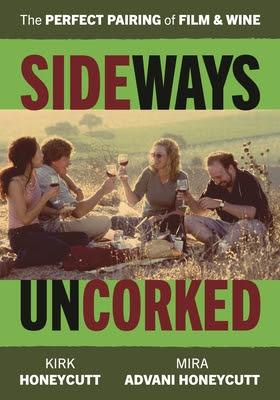“Sideways”: Grapes, Nuts, and Flakes

Quaffed any good pinot noir lately?The grape got new respect in 2004 via Alexander Payne’s Sideways, a boxoffice hit that was also a critical darling. (It was nominated for five Oscars,including Best Picture, and won for the adaptation of Rex Pickett’s comic novelby Payne and co-author Jim Taylor.) I’ve long used it in my UCLA Extensionadvanced screenwriting courses as one way to approach various aspects of thescreenwriter’s craft. Sideways provided a major boost to the actingcareers of Paul Giamatti and his castmates, as well as a shot in the arm totourism in California’s Santa Ynez Valley. It also upended the wine industry:after the advent of Sideways, merlot was considered by many to be a winegrape non grata.
In 2024, Applause Booksreleased Sideways Uncorked, described on its cover as “the perfectpairing of film and wine.” There’s no question that the authors know whereofthey speak. Kirk Honeycutt was for twenty years a writer and then the chieffilm critic of The Hollywood Reporter. So he knows the film world insideand out. His in-depth understanding of independent films like Sideways wasenhanced by his experience with low-budget maven Roger Corman on Final Judgement, a 1992priest-and-stripper quickie for which Kirk wrote the original screenplay. (AsRoger’s story editor I worked with Kirk on the project. I best recall a little momentin which the accused killer tries to get away from potential danger by climbingaboard a city bus. Roger refused to accept this quirky choice, reasoning that abadass required a motorcycle or something cooler than public transit. Thus myboss firmly rejected what I had found original and characteristic.)
In this book, it’s Kirk’s jobto explain how Sideways came to be, how it was written, financed, cast,shot, and distributed. Part of his focusis on the implications of Sideways being an indie film: by not allowinga studio with deep pockets to dictate key artistic choices (like the dreamcasting of George Clooney and Brad Pitt in the leading roles instead of theless glamorous Paul Giamatti and Thomas Haden Church), Payne preserved hisvision of this film as featuring two ordinary down-on-their-luck guys.
Kirk’s insider stories aboutthe making of Sideways, corroborated by the film’s cast and crew, areaugmented by the contributions of his wife, Mira Advani Honeycutt. A longtimewine journalist, she puts her expertise to work in explaining the realities ofthe wine industry, especially as this applies to the Santa Ynez Valley. Shebegins by focusing in on the all-important physical properties of the area,what the French call “terroir.” Theseare the environmental factors—relating to weather, soil quality, and thelike—that determine which grapes can be most successfully planted in a givenplot of land. Santa Barbara County’s Santa Ynez Valley offers vastly differentclimate conditions from Northern California’s famous grape-growing counties,and she traces the history of pinot noir cultivation in the region, showing indetail how this notoriously finicky grape (see Giamatti’s now-famous speechabout the special needs of pinot) thrives in its soil. For wine lovers, shealso advises on the best wineries for pinot noir in California, Oregon, andelsewhere. Nor does she neglect merlot, which is scorned by Giamatti’scharacter in the film, but certainly is worthy of having its own enthusiasts.It’s amusing to note that the book is dedicated “to Cinephiles, Pinotphiles,and Merlot Mavericks.”
Want to know how thereal-life owner of a Solvang restaurant made a fortune off the success of Sideways?This book’s for you.
Beverly in Movieland
- Beverly Gray's profile
- 10 followers



